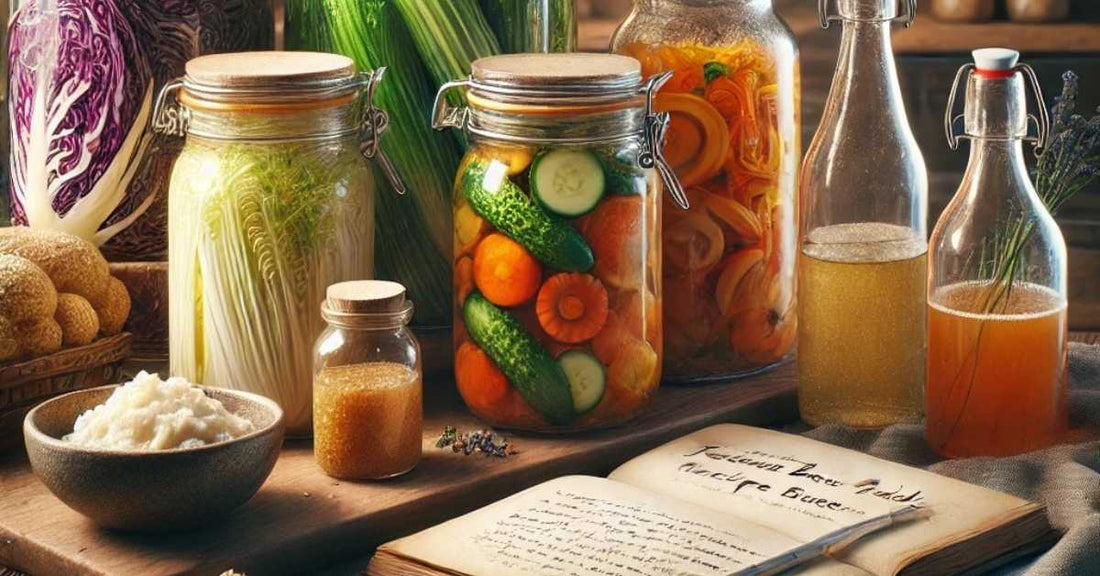
Fermentation Recipe Book Guide
Share
Natural and Healthy Fermentation Process
Fermented foods are both beneficial for health and very rich in flavor. At the same time, many fermented products, from yogurt to kefir and from pickles to kombucha, have a very rich content in terms of probiotics that strengthen the immune system. If you want to try and make fermented recipes at home, this type of book will be a good starting point to guide you. Trying fermented recipes with this guide will be more enjoyable for you. In this blog post, we will learn and examine good information about the fermentation process and fermented recipes. Let's take a look at what you need to know about the fermentation process at home and basic recipes.
What is Fermentation?
Fermentation is a natural process that occurs when microorganisms, namely bacteria and yeasts, break down the sugars and starches in foods. Thanks to this process, foods can be stored and preserved for a long time and become beneficial for the digestive health of individuals. Fermented foods support intestinal health, facilitate digestion, and also strengthen the immune system.
What are the Benefits of Fermented Foods?
Fermented foods have many benefits for human health. Some of the important benefits are as follows:
- Strengthening the Immune System: Fermented foods containing probiotics support the immune system by balancing the intestinal flora. In this way, individuals have a healthier intestinal system.
- Supporting Digestive Health: Natural probiotics make digestion as easy as possible by increasing the beneficial bacteria in the intestine.
- High Vitamin and Mineral Content: The fermentation process increases the vitamin and mineral content in foods by a large amount.
- Long Shelf Life: Fermented foods can be stored for a long time without spoiling because they contain natural preservatives. Thus, the shelf life of such foods is long.
Ingredients Required for Fermentation
The materials you need to make fermented foods at home are as follows:
- Glass jars
- Clean water
- Sea salt or rock salt
- Organic vegetables or dairy products
- Starter cultures (such as probiotic yeast or kefir yeast)
- Cotton cloth or breathable lids
Thanks to these materials, you can easily and comfortably prepare fermented foods at home.
Some Fermented Recipes You Can Easily Make at Home
1. Homemade Sauerkraut
Ingredients: 1 large cabbage, 1 tablespoon rock salt, 1 teaspoon cumin seed if desired
Preparation: Finely chop the cabbage and place it in a large bowl. Then add the rock salt and knead it well with your hands and mix. During this time, the cabbage will start to release its water. Place the mixture you prepared tightly in a glass jar and cover it with a weight. Cover the jar with a clean cloth and leave it at room temperature for 7-14 days. After fermentation, you can store it in the refrigerator and consume it.
2. Making Kefir
Ingredients: 1 liter of unpasteurized natural milk, 1 tablespoon of kefir yeast
Preparation: Transfer the milk to a glass jar and add the kefir yeast. Then cover the jar with a clean cloth and leave it in a dark place for 24 hours. After 24 hours, you can strain the fermented kefir and store it in the refrigerator.
3. Making Kombucha (Fermented Tea)
Ingredients: 1 liter of water, 4 bags of black or green tea, half a glass of sugar, 1 kombucha mushroom (SCOBY), half a glass of previous kombucha tea
Preparation: Boil the water and add the tea bags. After the tea is brewed, add the sugar and stir. Wait for the mixture to cool completely. After it cools, pour it into a glass jar and add the kombucha mushroom. After adding the mushroom, cover it with a cloth and let it ferment for 7-10 days. At the end of the period, you can strain the kombucha and store it in the refrigerator.
Storage Conditions of Fermented Foods
The points to be considered for the long shelf life of fermented foods are as follows:
- Fermented products should always be stored in glass jars.
- Foods fermented at room temperature should definitely be stored in a cool environment.
- After opening fermented food, you can keep it fresh by storing it in the refrigerator.
- You should check the jars regularly and observe if there is mold.
In summary
Trying fermented recipes at home will be a great experience for both your health and the further development of your culinary culture. The fermentation process, which is carried out patiently with the right ingredients, strengthens your immune system and helps you consume delicious and nutritious foods. If you want to try fermented vegetables and other probiotic foods at home, you can obtain and enjoy natural and healthy foods by applying the recipes we share in this article! Enjoy your meal…

The Noma Guide to Fermentation
Discover the ultimate Fermentation Recipe Book Guide! Learn step-by-step fermentation techniques, must-have tools, and delicious probiotic-rich recipes to boost gut health and enhance your meals Check it out on Amazon.
